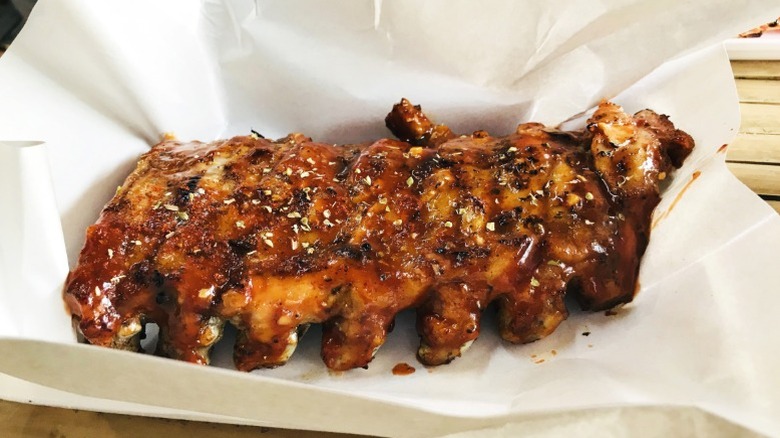The Melting Pot Of Influences That Make Chicago-Style BBQ Different From Any Other
By this point, you're probably familiar with Chicago-style food even if you've never set foot in the Windy City. You've heard of Chicago-style deep dish pizza, even though it's not actually the choice of most Chicagoans; you've heard of Chicago-style hot dogs, which are served on poppy seed buns and loaded with pickles, vegetables, and relish; thanks to "The Bear", you've heard of the Italian beef, which is essentially a Chicago-style steak sandwich. But have you heard of Chicago-style barbecue? Maybe you haven't, which is a shame: Thanks to a diverse melting pot of influences, it's as interesting and distinctive as any other regional barbecue style you'd care to name.
Although barbecue has a long history in the Chicago area — the Chicago Tribune traces its first mentions in the press back to the 1850s — barbecue restaurants didn't come along until much later. Most barbecue events before then were special occasions, often political fundraisers that served thousands of people. It wasn't until the 1930s that barbecue restaurants started to appear in Chicago, coinciding with an influx of African-Americans who moved to Chicago from the South as part of the Great Migration. Looking to escape the segregation of the Jim Crow South, these people brought their regional barbecue with them, which ended up melding with the sausage-based cuisine of Chicago's sizable Polish immigrant population in a fascinating way.
Ribs, rib tips, and hot links feature in Chicago-style barbecue
So what does Chicago-style barbecue have to offer? It depends on where you go. The kind of barbecue you get on the North Side of Chicago may differ greatly from the kind you get on the South Side. But if you want to see what's really unique about Chicago-style barbecue, you have to know about what kind of meat you might get. There are ribs, of course, but there are also rib tips, which are just what they sound like: the chewy, cartilage-dense tips from a rack of ribs. (Usually they're cut off before cooking.) Because they're ultra-flavorful while still being priced like a byproduct, they're a popular option for Chicago barbecue joints. There are hot links, too: spicy smoked sausages, the aforementioned melding of Black barbecue and Polish sausage traditions.
These aren't just cooked in any old smoker, either. Chicago barbecue makes use of something called an "aquarium smoker" (because it looks like a giant fish tank). Made of steel and glass, these smokers can be used to cook large amounts of food indoors without smoking up the joint too severely, with the clear glass making it easier to monitor when the meat is ready. It's another unique part of this singular regional scene.

